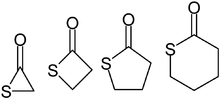Thiolactone

Thiolactones are a class of heterocyclic compounds in organic chemistry. They are analogs of the more common lactones in which an oxygen atom is replaced with a sulfur atom. The sulfur atom is within the ring system and adjacent to a carbonyl group.
Chemistry
Thiolactones can be prepared by dehydration of thiol-containing carboxylic acids. Thiolactones can be hydrolyzed back to the thiol acids under basic conditions.[1] β-Thiolactones can be opened by reaction at the 4-position via SN2 nucleophilic reactions.[2]
Occurrence
The most common thiolactone, homocysteine thiolactone is produced biochemically from homocysteine and it may play a role in protein damage.[3] The thiolactone functional group is also present in some pharmaceutical drugs such as citiolone and erdosteine. Thiolactone rings can also be found in peptides synthesized by bacteria such as Staphylococcus aureus in order to regulate their quorum-sensing system.[4]
References
- ↑ Stevens, Charles M.; Tarbell, D. Stanley (1954). Journal of Organic Chemistry 19 (12): 1996–2003. doi:10.1021/jo01377a017. Missing or empty
|title=(help) - ↑ Crich, David; Sana, Kasinath (2009). "SN2-Type Nucleophilic Opening of β-Thiolactones (Thietan-2-ones) as a Source of Thioacids for Coupling Reactions". The Journal of Organic Chemistry 74 (9): 3389–3393. doi:10.1021/jo9001728. PMID 19388715.
- ↑ Jakubowski, H (2000). "Homocysteine thiolactone: Metabolic origin and protein homocysteinylation in humans". The Journal of nutrition 130 (2S Suppl): 377S–381S. PMID 10721911.
- ↑ Malone, C.L (2007). "Biosynthesis of Staphylococcus aureus Autoinducing Peptides by using the Synechocystis DnaB Mini-Intein". Applied and Environmental Microbiology 73 (19): 6036–6044. doi:10.1128/aem.00912-07.